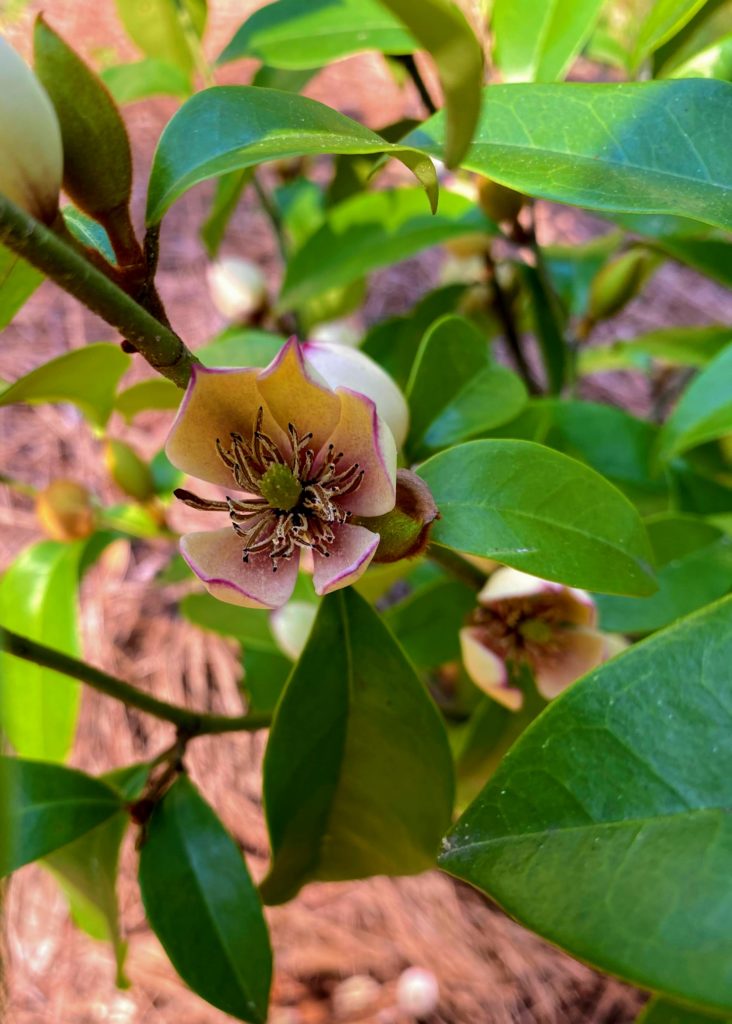
I can’t help myself. Woody ornamentals are my weakness. They are the biggest temptation for me lately, and in a weak moment I will buy a shrub, or small tree, with no real consideration what I’m going to do with it. This is bad. Very bad. This is exactly what I tell people not to do in my book.

I wasn’t always this way. Many years ago, pots of elegant Japanese anemones on display at the very posh garden center in town gave me heart palpitations. Back then, as a new gardener, I was obsessed with blooms, and there were so many things to love. Today, with several types of Japanese anemones growing happily in my garden, my thoughts have turned to other delights.
I’m not sure when this shrub love affair began, but I hear from other gardeners this is just the way it goes. Growing flowers makes you so very happy, so you think, and then years later you realize that shrubs are the long-term relationship you’ve been longing for.

Don’t get me wrong, I grow many types of flowering plants from seed, and I buy pots of annuals and perennials when they meet the criteria of being (a) deer resistant and (b) having blooms and/or foliage that fit with the color schemes in various parts of my garden. After all, I need the flowers to complete the picture I’m creating with the shrubs…well, you can see the slippery slope I’m on.
Flowers are wonderful, but shrubs and trees give your garden a soul.

If you’re planning a new landscape, follow my advice and do work out the structure of your garden with shrubs and trees before you get too far down the road with perennials. You’ll be glad you did. Shrubs and small-scale trees will give your garden the good bones that will give you pleasure for years and years to come. (If you need a bit of help, my book, Color-Rich Gardening for the South, a primer for new gardeners who love color, will help you plan and make good decisions.)

Here are some of my favorites for Southern gardens with notes on light requirements:
Shade = SH
Part Shade = PTSH
Sun = S
Amelanchier x grandiflora ‘Autumn Brilliance’ , serviceberry (S)
Amelanchier spp, the native juneberry (S)
Fothergilla x intermedia ‘Mount Airy’ (S or PTSH)
Aronia melanocarpa, the native black chokeberry (S or PTSH)
Aronia melanocarpa ‘Low Scape Mound’ (S or PTSH)
Illicium floridanum ‘Pink Frost’, anise (PTSH or S)
Loropetalum chinense ‘Snow Emerald’ (PTSH)
Osmanthus fragrans, tea olive (PTSH or SH)
Hydrangea paniculata ‘Limelight’ (PTSH or SH)
Camellia japonica ‘Shi shi gashira’ (PTSH or SH)
Acer palmatum ‘Sango-kaku’, Coral bark maple (PTSH)
Halesia carolina, native Carolina Silverbell (S or PTSH)
Chionanthus virginicus, native fringe tree, (S or PTSH)
Ecualyptus parvula ‘Funky Monkey’, eucalyptus (S)
Abelia x chinensis ‘Rose Creek’, abelia (S or PTSH)
Michelia figo, Banana Shrub (S)
Callicarpa americana, beautyberry (S)
Callicarpa ‘Pearl Glam’, beautyberry cultivar (S)
Vaccinium darrowii ‘Rosa’, Rosa’s Blush Dwarf Blueberry, native (PTSH or S)
Malus x ‘Pink Princess’, crabapple (S)
Viburnum tinus ‘Spring Bouquet’, viburnum (S)
Hydrangea quercifolia ‘Pee Wee’, dwarf native oakleaf hydrangea (PTSH)